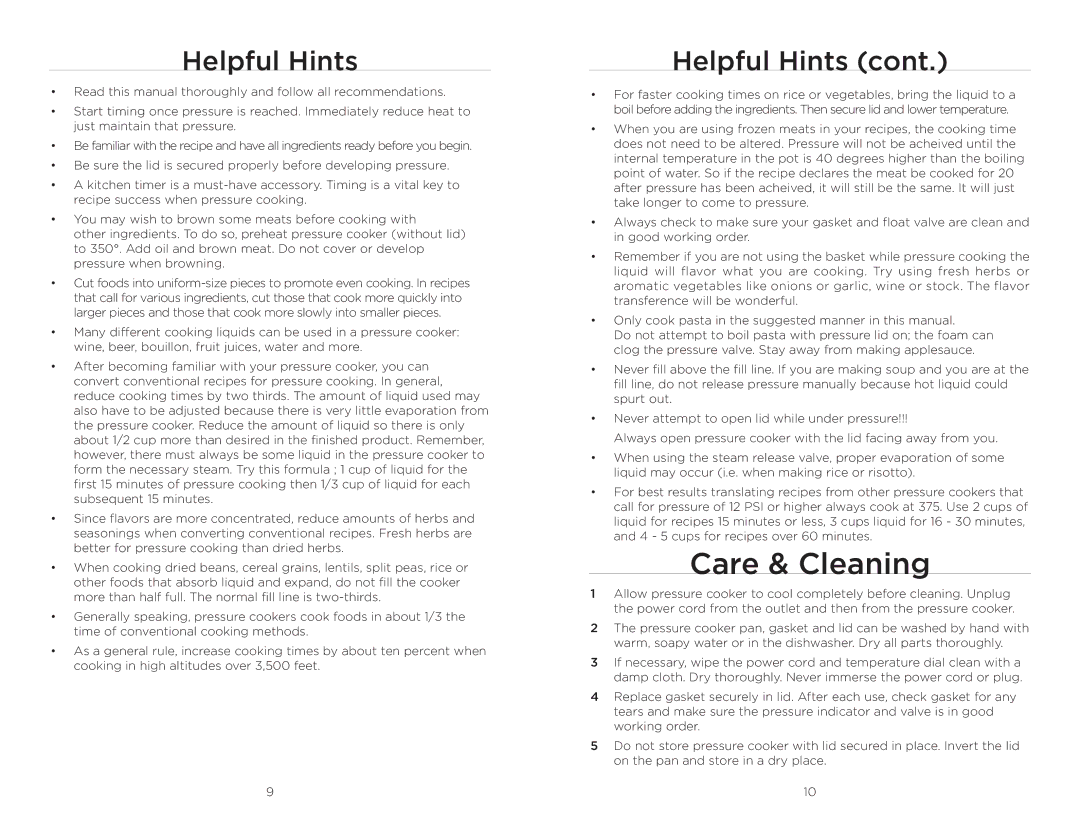
Helpful Hints
•Read this manual thoroughly and follow all recommendations.
•Start timing once pressure is reached. Immediately reduce heat to just maintain that pressure.
•Be familiar with the recipe and have all ingredients ready before you begin.
•Be sure the lid is secured properly before developing pressure.
•A kitchen timer is a
•You may wish to brown some meats before cooking with
other ingredients. To do so, preheat pressure cooker (without lid) to 350°. Add oil and brown meat. Do not cover or develop pressure when browning.
•Cut foods into
•Many different cooking liquids can be used in a pressure cooker: wine, beer, bouillon, fruit juices, water and more.
•After becoming familiar with your pressure cooker, you can convert conventional recipes for pressure cooking. In general, reduce cooking times by two thirds. The amount of liquid used may also have to be adjusted because there is very little evaporation from the pressure cooker. Reduce the amount of liquid so there is only about 1/2 cup more than desired in the finished product. Remember, however, there must always be some liquid in the pressure cooker to form the necessary steam. Try this formula ; 1 cup of liquid for the first 15 minutes of pressure cooking then 1/3 cup of liquid for each subsequent 15 minutes.
•Since flavors are more concentrated, reduce amounts of herbs and seasonings when converting conventional recipes. Fresh herbs are better for pressure cooking than dried herbs.
•When cooking dried beans, cereal grains, lentils, split peas, rice or other foods that absorb liquid and expand, do not fill the cooker more than half full. The normal fill line is
•Generally speaking, pressure cookers cook foods in about 1/3 the time of conventional cooking methods.
•As a general rule, increase cooking times by about ten percent when cooking in high altitudes over 3,500 feet.
Helpful Hints (cont.)
•For faster cooking times on rice or vegetables, bring the liquid to a boil before adding the ingredients. Then secure lid and lower temperature.
•When you are using frozen meats in your recipes, the cooking time does not need to be altered. Pressure will not be acheived until the internal temperature in the pot is 40 degrees higher than the boiling point of water. So if the recipe declares the meat be cooked for 20 after pressure has been acheived, it will still be the same. It will just take longer to come to pressure.
•Always check to make sure your gasket and float valve are clean and in good working order.
•Remember if you are not using the basket while pressure cooking the liquid will flavor what you are cooking. Try using fresh herbs or aromatic vegetables like onions or garlic, wine or stock. The flavor transference will be wonderful.
•Only cook pasta in the suggested manner in this manual.
Do not attempt to boil pasta with pressure lid on; the foam can clog the pressure valve. Stay away from making applesauce.
•Never fill above the fill line. If you are making soup and you are at the fill line, do not release pressure manually because hot liquid could spurt out.
•Never attempt to open lid while under pressure!!!
Always open pressure cooker with the lid facing away from you.
•When using the steam release valve, proper evaporation of some liquid may occur (i.e. when making rice or risotto).
•For best results translating recipes from other pressure cookers that call for pressure of 12 PSI or higher always cook at 375. Use 2 cups of liquid for recipes 15 minutes or less, 3 cups liquid for 16 - 30 minutes, and 4 - 5 cups for recipes over 60 minutes.
Care & Cleaning
1Allow pressure cooker to cool completely before cleaning. Unplug the power cord from the outlet and then from the pressure cooker.
2The pressure cooker pan, gasket and lid can be washed by hand with warm, soapy water or in the dishwasher. Dry all parts thoroughly.
3If necessary, wipe the power cord and temperature dial clean with a damp cloth. Dry thoroughly. Never immerse the power cord or plug.
4Replace gasket securely in lid. After each use, check gasket for any tears and make sure the pressure indicator and valve is in good working order.
5Do not store pressure cooker with lid secured in place. Invert the lid on the pan and store in a dry place.
9 | 10 |
